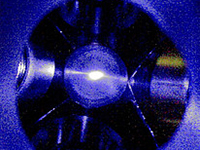原子レーザー冷却 & トラッピングのための波長可変レーザーと周波数コム
レーザー冷却と原子の磁気光学トラッピング
- ドップラー冷却
- シシフォス冷却 / 偏光勾配冷却&光モラセス
- ラマン冷却と特殊レーザー冷却スキーム
- 磁気光学トラッピング(MOT)
- 原子泉
- 原子リソグラフィー
- 光ダイポールトラッピング
過去一世紀にわたり、物質波や光と原子の相互作用に関する多くの実験や理論研究が現代の原子光学とその基礎研究、また産業応用への道を切り開いてきました。中性原子のレーザー冷却は1985年頃に初めて実証されました。1997年には“for development of methods to cool and trap atoms with laser light”の功績に対しスティーブン・チュー、クロード・コーエン-タンヌージ、ウィリアム・フィリップスの3人にノーベル賞が授与されました。
その後、多くの異なるレーザー冷却・トラッピングに関するメカニズムが実証され、さらに多くの原子種がレーザー冷却研究の対象とされてきました。現在における冷却温度はマイクロケルビンの範囲内にあり宇宙空間のどの場所よりも何桁も寒く、絶対零度よりも数百万分の一程度の極低温が実現されてきました。レーザー冷却された原子雲は本当に「クール」なものです!レーザー冷却された原子雲は一般的に原子と光の相互作用を研究するために使用され、ボース-アインシュタイン凝縮や縮退フェルミガス、原子干渉法、原子衝突研究、時間と周波数の精密測定、加速と回転、同位体比、基本定数などのような様々な実験のための冷たい原子源としての役割を果たしています。
レーザー冷却(Laser cooling)
レーザー冷却は特殊な光場や光パルスを原子の集合体に適用することで達成されます。エネルギーと運動量は、原子が原子の直接冷却につながる摩擦力を経験するかまたは、原子が光子を散乱しなくなるため、原子が閉じ込められた低い運動量の特定の量子力学的状態(例えば、ハーモニックトラップ内の振動状態)に光学的に励起されるような方法で光子と原子の間で交換されます。原子光学で最も一般的に使用されているレーザー冷却スキームはドップラー冷却と偏光勾配冷却またはシーシャス冷却です(アプリケーションノートを参照)。ラマンレーザー冷却はトラップされた原子と一緒に使用されることもありますがトラップ内のイオンに適用されることが多くなっています。より特殊な方式ですが物理的にも興味深いレーザー冷却方式としてはVSCPTや脱分極/減磁冷却が上げられますが、これはおそらく古典的な提案となる光冷却方式でしょう(既に2006年に実証されています)。
レーザー冷却に用いられる中性原子元素の原子番号順の一覧:(見つからない元素があれば御連絡下さい。トプティカ特製マグカップをプレゼント)
H, anti-H, He*、Li、Ne*、Na、Mg、Al、Ar*、K、Ca、Cr、Fe、Ga、Kr、Rb、Sr、Ag、Cd、In、Xe、Cs、Ba、Eu*、Dy、Ho、Er、Tm、Yb、Hg、Fr、Ra(まだまだ続きます)。
磁気光学トラッピング(Magneto-optical trapping)
磁気光学トラッピングはレーザー冷却の摩擦力と原子位置に依存した「復元力」を組み合わせた手法です。位置依存力を実現するためには磁気光学トラップ(MOT)の中心(磁場がゼロになる位置)で磁気四重極磁場と直交する3本のレーザービームが交差します。このため、位置依存性のあるゼーマン効果は円偏光とレーザービームの周波数と相互作用し原子は常にMOTの中心に向かって押し出されます。この結果、レーザーで冷却された元素のほとんどがMOT内に閉じ込められます。典型的な原子数は数千から数十億個、温度はマイクロからミリケルビンの範囲で、密度は10^8 to 1011 atoms/cm3です。
原子泉(Atomic fountains)
原子泉はMOT内に所望の数の原子が蓄積して熱化した後に磁場を切り替えて、上向きレーザーと下向きレーザーの周波数差をオンにすることで、MOTから発生させることができます。このようにして原子は移動フレームの中で冷却され、十分に制御された速度で上に移動します。上昇中の原子は重力によって減速され折り返し地点に到達した後に再び下降します。このような原子泉の主な利点は放出された原子の観察や相互作用が1秒以内に劇的に増加することであり、精密測定を行う上で大きな利点となります。最終的には原子は再捕された後に再び放出されることで原子ジャグリングが可能になります。
原子リソグラフィーと光学ダイポールトラップはいわゆる双極子力に基づいています。レーザーは原子内に振動する電気双極子を誘導しレーザービーム自体の電界と相互作用して保守的な光学ポテンシャルを形成します。この光学ポテンシャルはレーザーの強度によって変化し、その勾配によって双極子力が生じます。レーザーの周波数が原子の共振周波数以下であれば原子の双極子と電場は位相を変えて振動し光学ポテンシャルは負になります。原子は光場の最大強度に向かって双極子力を経験します。強く集光されたレーザービームはその焦点の中心で原子をトラップし、いわゆる光学ピンセットまたは光学双極子トラップを形成することが可能になります。より複雑な光学トラップはレーザービームを1次元、2次元、あるいは3次元で対向伝播させることにより、又は1次元、2次元、あるいは3次元の光学格子を形成することにより作成されます。これらの光格子は光の波長の半分(1µm以下)に最大の強度を持つ光で作られた完全な「結晶」構造でありトラップされた原子を用いた固体物理学の研究やシミュレーションに使用されます。光学的ポテンシャルは従来の物質と光の役割を逆転させて、原子放射のためのレンズを生成するためにも使用することができ、用意された物質(例えば、ガラスレンズ)が光線の焦点を合わせるように使用されます。原子リソグラフィーでは原子ビームが特殊な光学的構造部を介して送られ、この光レンズによって基板上に集光されることでナノメートルスケールの原子構造が形成されます。
TOPTICA社が原子光学に新たな”価値”をもたらします
原子光学はレーザーアプリケーションにおける最も挑戦的な分野です。最新の科学研究トピックに応じて常に変化するユーザーの要求に応じて特別な、あるいはカスタマイズされたレーザーが必要とされています。レーザーシステムは所望の(そして急速に変化する)様々な波長で十分なパワーを提供しなければなりません。発振線幅は原子遷移の線幅以下(典型的にはMHzレンジですが最新の実験ではkHzのレンジにも及んでいます)、または原子遷移と希望のレーザー周波数の差以下でなければなりません。モードホップフリーな波長微調整つまりレーザー周波数を非常に精密に調整することで原子遷移周波数に近い明確な位置にレーザー周波数を設定し、また高度に安定化させることが可能になります。複雑なレーザーシステムであっても実験で成功を収めるためにはより多くのレーザーが同時に、かつ確実に動作する必要があるため操作が容易であることも求められています。
トプティカ社はノーベル賞受賞者のみならず、世界中の多くの研究グループにこのようなレーザーシステムを提供しています。10年以上前から、常に研究の最前線で製品の品質と柔軟性を追求してきたことで高い御評価を頂いています。当社では常に新しいレーザーシステムを開発しておりユーザーのご要望に応じた特別かつ最先端のソリューションを提供しています。高度な品質管理システム、産業向け量産/OEM製造能力、プロフェッショナルなサービス部門を持つ専門的に組織化された会社であるにもかかわらず、当社は創業の原点である基礎科学への情熱を忘れていません。世界中の多くの研究グループとのパートナーシップは当社のビジネスにとって必要なだけでなく、顧客と共に知的好奇心を探求できることに大きな喜びを感じています。トプティカ社にはユーザーのアプリケーションやご要望を理解した原子光学に精通したエキスパートが多数在籍しています。レーザー製品だけでなく、あなたの実験の詳細についてもお気軽にお問い合わせください。
Magneto-optical trapping
Magneto-optical trapping combines the friction force of laser cooling with a “restoring” force depending on the atomic position. In order to realize the position dependent force, a magnetic quadrupole field combined with three orthogonal pairs of counter-propagating laser beams intersect at the center of the magneto-optical trap (MOT), the location where the magnetic field is zero. The therefore position-dependent Zeeman effect interplays with the circular polarization and the frequency of the laser beams such that atoms are always pushed towards the MOT center. Most of the laser cooled elements have also been trapped in MOTs. Typical atom numbers range from a few thousand to a few billion of atoms at temperatures in the micro to millikelvin range and densities of typically 108 to 1011 atoms/cm3.
Atom lithography and optical dipole traps
Atom lithography and optical dipole traps are based on the so-called dipole force. The laser induces an oscillating electric dipole in the atom which interacts with the electric field of the laser beam itself to form a conservative optical potential. The optical potential varies with the laser intensity and its gradient gives rise to the dipole force. If the laser frequency is below the atomic resonance frequency, the atomic dipole and the electric field oscillate in phase and the optical potential is negative. Atoms experience a dipole force towards the intensity maximum of the light field. A tightly focused laser beam can then trap atoms at the center of its focus and form a so-called optical tweezer or optical dipole trap. More complex optical traps are created by counter-propagating laser beams in one, two or even three dimensions forming 1-d, 2-d or even 3-d optical lattices. These optical lattices – perfect crystals made out of light with intensity maxima at every half of the optical wavelength (typ. < 1 µm) – are used to study and simulate solid state physics with trapped atoms. Optical potentials can also be used to generate lenses for rays of atoms reversing the traditional roles of matter and light where an arrangement of matter (e.g. a glass lens) is used to focus a ray of light. In atom lithography, a beam of atoms is sent through a special light configuration and focused by this light lens onto a substrate where it forms atomic structures on the nm scale.
TOPTICA’s added value in laser cooling-based quantum technologies
Quantum technology applications require special or even customized lasers with always constantly evolving demands according to the newest developments and changing scientific research topics: The laser systems have to provide enough power at the desired wavelength. The linewidth has to be below the linewidth of the atomic transition (typ. MHz but in recent experiments also in the kHz or even Hz range) or the difference between atomic transition and desired laser frequency. Mode-hop-free fine tuning, that is very precise adjustment of the laser frequency, allows one to set or even stabilize the laser frequency at a well-defined position close to the atomic transition frequency. Even complex laser systems have to be easy to operate since nowadays more and more lasers have to work simultaneously and reliably in order to have experimental success. Remote, digital control of the laser is another feature becoming increasingly essential.
TOPTICA is key supplier of such laser systems to most research groups and to quantum technology industry all around the world. Since more than two decades, we are well known for the quality of our products always at the front line of research and for our flexibility. We are constantly developing new laser systems and are open for special solutions according to customers’ demands. You will find experts at TOPTICA with profound quantum technology background that understand your application and your requirements. Please contact us to discuss details of your plans.

